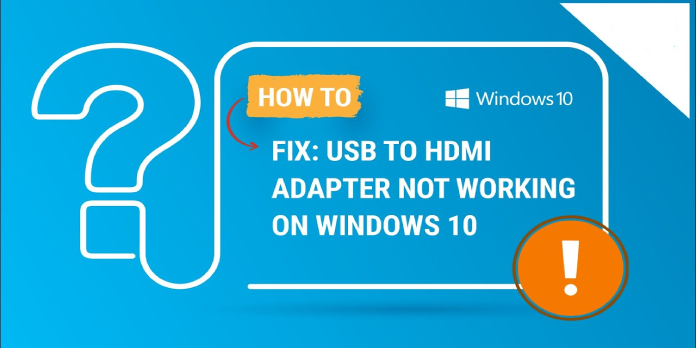Here we can see, “How to: Fix USB to HDMI Adapter Not Working on Windows 10/11”
- If your USB-C to HDMI converter isn’t working, the problem could be due to a malfunctioning dedicated driver.
- As a result, we recommend utilizing a specialist tool to update the USB to the HDMI driver.
- Recently installed Windows 10 upgrades, on the other hand, can cause issues with cables and ports.
- Of course, the issue could be hardware-related, referring to the adapter.
Users can connect their desktops or laptops to secondary display devices through HDMI using USB to HDMI adapters, even if they do not have an HDMI port.
However, some Windows 10 users have reported that USB to HDMI adapters may not always function. A few people have even complained about their USB to HDMI adapters not working on the Microsoft forum.
I’m working on an HP-21 Pavilion all-in-one computer. Unfortunately, my computer lacks a VGA or HDMI port. To connect the projector and second monitor on this PC (Windows 10), I used a display link USB-HDMI Display Adapter. It was a huge success. However, it ceased operating after the Windows 10-anniversary patches. So I used the most recent Display Link drivers. As a result, THE SCREEN GOES BLACK when I connect a USB adapter into the built-in USB port.
Why won’t my USB-C to HDMI adaptor work on Windows 11?
If this happens, it’s possible that your HDMI port isn’t working; check it with a different cable to verify sure everything is in working order.
Many people utilize docking stations to get around this problem however unfortunately, few customers have complained that Windows 11 does not identify docking stations.
This isn’t the only cable with problems; several people have claimed that their USB-C to DisplayPort cable isn’t working, but this is a simple cure.
What can I do about the USB to HDMI adaptor problem?
1. Install the latest USB to HDMI driver
- Press Windows Key + S and type Device Manager into the search box.
- Expand Other Devices in the Device Manager.
- Select Update Driver from the context menu of your USB device.
An incorrectly installed or incompatible device driver can cause a USB to HDMI adapter issue. As a result, updating the USB to the HDMI adapter’s driver may be able to resolve the issue.
Drivers are updated automatically
You can get the most recent USB to HDMI driver from the manufacturer’s website. You should be able to find a suitable driver with some research.
However, utilizing a specialized third-party program that will automatically scan your hardware for the latest available version and download it is the best approach to update your drivers.
2. Go back in time using a Windows 10 build update
- By pressing the Windows Key + S, you can access the search box.
- Then, in the search box, type Updates.
- To open Settings, click Recovery.
- Then, under Get started, select the Get started button. Finally, return to the previous subheading of the Windows 10 section.
- After an update, you can roll back a Windows 10 build update for ten days.
- Then follow the instructions to roll back the platform.
Following Windows 10 build updates, several users have reported that their USB to HDMI adapters have ceased working. Use the steps outlined above to roll back a recent Windows 10 build upgrade.
3. Switch to a different USB port/change hub
There could be a problem with the USB port you’re using to connect your USB to the HDMI adapter. As a result, try connecting your USB to an HDMI converter via a different port on your computer or laptop.
Alternatively, if you have a spare USB to HDMI hub, try switching between them to determine whether it’s a hardware issue.
4. Examine the hardware for any modifications
- Select Device Manager from the Win + X menu by right-clicking the Windows 10 Start button.
- At the top of Device Manager, select your PC.
- To access that option, click Action.
- Select the option to scan for hardware changes.
- After scanning, try using the USB to HDMI adaptor.
After you scan for hardware changes, Windows may detect a connected USB to HDMI converter.
The above resolutions may repair USB to HDMI adapters for some people, but not for everyone. As a result, some users may need to replace their adapters.
Conclusion
I hope you found this guide useful. If you’ve got any questions or comments, don’t hesitate to use the shape below.
User Questions:
1. What is the best way to use a USB to HDMI converter in Windows 10?
- Change the source of the external display.
- Connect your main device to the USB-HDMI adaptor (laptop, computer, or smartphone).
- Attach the HDMI cable to the adaptor. An external display should already be linked to the HDMI.
- Return to HDMI as the external display source.
2. Why isn’t my HDMI in Windows 11 working?
The most popular solutions for Windows 11 not detecting HDMI TV or Monitor are listed below. Make sure the HDMI cable is properly seated in the TV or monitor’s HDMI port. Remove any dust or debris from the HDMI port. For this, use a soft-bristled brush or a microfiber cloth.
3. Is it possible to connect a USB-C device to an HDMI port on Windows?
Sabrent Dual HDMI USB Type-C Adapter
Sabrent’s HDMI adapter makes it simple to connect two HDMI monitors or other devices with this sort of connector. You will be able to utilise both devices at the same time. The adapter works with Windows 10 devices in both SST and MST modes, as well as HDCP.
4. Fix for Windows 11 USB-C To HDMI Dongle failure – Reddit
Fix for Windows 11 USB-C To HDMI Dongle failure. from Windows11
5. USB to HDMI not working : r/Monitors – Reddit



